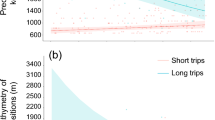Abstract
We examined the risk-sensitive foraging behaviour of the round-eared elephant shrew by open-economy choice experiments, in which animals were deprived of food immediately prior to experiments but given food ad libitum afterwards, to test the energy budget rule. The energy budget rule states that if an animal's (daily) energy budget is negative it should behave in a risk-prone manner. A risk-prone elephant shrew should select food from a more variable rather than a constant feeding station, although both feeding stations yield the same average return. The choice of a variable station can indicate the degree to which an animal is an energy-shortfall minimizer. Elephant shrews running below energy requirement did not choose feeding stations in accordance with the rule. Under laboratory conditions, approximating either average summer or winter temperatures, elephant shrews showed risk-averse behaviour. A polycyclic activity profile, the ability to switch the diet, and greater than expected physiological control over energy balance, may favour a continuously foraging animal such that short-term energy deficits are minimized. We argue that, under these conditions, a risk-averse response to reward-size variance is expected, because an elephant-shrew may not reliably perceive those circumstances under which risk-prone behaviour should be adopted.
Similar content being viewed by others
References
Barnard CJ, Brown CAJ (1985) Risk-sensitive foraging in common shrews (Sorex araneus L.). Behav Ecol Sociobiol 16:161–164.
Barnard CJ, Brown CAJ, Houston AI, McNamara JM (1985) Risksensitive foraging in common shrews: an interruption model and the effects of mean and variance in reward rate. Behav Ecol Sociobiol 18:139–146.
Barkan CPL (1990) A field test of risk-sensitive foraging in blackcapped chickadees (Parus atricapillus). Ecology 71:391–400.
Battalio RC, Kagel JH, MacDonald DN (1985) Animals' choices over uncertain outcomes: some initial experimental results. Am Econ Rev 75:597–613.
Caraco T (1980) On foraging time allocation in a stochastic environment. Ecology 61:119–128.
Caraco T (1981) Energy budgets, risk and foraging preferences in dark-eyed juncos. Behav Ecol Sociobiol 8:213–217.
Caraco T (1982) Aspects of risk-aversion in foraging white-crowned sparrows. Anim Behav 30:719–727.
Caraco T (1983) White-crowned sparrows (Zonotrichia leucophrys): foraging preferences in a risky environment. Behav Ecol Sociobiol 12:63–69.
Corbet GB (1971) Part 1.5: Family Macroscelididae. In: Meester J Setzer HW (eds) The mammals of Africa: an identification manual. Smithsonian Institution, Washington D.C.,.
Downs CT, Perrin MR (1990a) Field water-turnover rates of three Gerbillurus species. J Arid Environ 19:199–208.
Downs CT, Perrin MR (1990b) Thermal parameters of four species of Gerbillurus. J Therm Biol 15(3–4):291–300.
Downs CT, Perrin MR (1991) Physiological adjustments to low temperatures of four Gerbillurus species. J Therm Biol 16: 25–29.
Downs CT, Perrin MR (1993) An investigation of the macro- and micro-environments of four Gerbillurus species. Cimbebasia 11:41–54.
Fielden LJ, Perrin MR, Hickman GC (1990) Feeding ecology and foraging behaviour of the Namib Desert golden mole, Eremitalpa grand namibensis (Chrysochloridae). J Zool Lond 220:367–389.
Ha JC, Lehner PN, Farley SD (1990) Risk-prone foraging behaviour in captive jays, Perisoreus canadensis. Anim Behav 39:91–96.
Heiner RA (1983) The origin of predictable behaviour. Am Econ Rev 73:560–595.
Houston AI, McNamara JM (1982) A sequential approach to risktaking. Anim Behav 30:1260–1261.
Houston A, McNamara J (1985) The choice of two prey types that minimises the probability of starvation. Behav Ecol Sociobiol 17:135–141.
Hursh SR (1980) Economic concepts for the analysis of behavior. J exp Anal Behav 34:219–238.
Kerley GIH (1989) Diet of small mammals from the Karoo, South Africa. S Afr J Wildl Res 19:67–72.
Kerley GIH (1992) Trophic status of small mammals in the semiarid Karoo, South Africa. J Zool Lond 226:563–572.
Leon B, Shkolnik A, Shkolnik T (1983) Temperature regulation and water metabolism in the elephant shrew Elephantus edwardi. Comp Biochem Physiol 74A:399–402.
McNamara JM, Houston AI (1982) Short-term behaviour and lifetime fitness. In: McFarland DJ (ed) Functional ontogeny. Pitman, London.
Real L, Caraco T (1986) Risk and foraging in stochastic environments. Annu Rev Ecol Syst 17:371–390.
Roxburgh L, Perrin MR (1994) Temperature regulation and activity pattern of the round-eared elephant shrew Macroscelides proboscideus. J therm Biol, (in press).
Sauer EGF, Sauer EM (1971) Die kurzohrige elefantenspitzmaus in der Namib. Namib Meer 2:5–43.
Sequignes M (1983) La torpeur chez Elephantulus rozeti (Insectivora, Macroscelididae). Mammalia 47:87–91.
Skinner JD, Smithers RHN (1990) The mammals of the Southern African subregion. 2nd edn. University of Pretoria, Pretoria.
Stephens DW, Charnov EL (1982) Optimal foraging: some simple stochastic models. Behav Ecol Sociobiol 10:251–263.
Stephens DW, Krebs JR (1986) Foraging theory. Princeton University Press, Princeton.
Woodall PF (1987) Digestive tract dimensions and body mass of elephant shrews (Macroscelididae) and the effects of season and habitat. Mammalia 51:538–545.
Woodall PF, Mackie RI (1987) Caecal size and function in the rock elephant shrew Elephantus myurus (Insectivora, Macroscelididae) and the Namaqua rock mouse Aethomys namaquensis (Rodentia, Muridae). Comp Biochem Physiol 87A:311–314.
Woodall PF, Woodall LB, Bodero DAV (1989) Daily activity patterns in captive elephant shrews (Macroscelididae). Afr J Ecol 27:63–76.
Wunderle JM, O'Brien TG (1985) Risk aversion in hand-reared bananaquits. Behav Ecol Sociobiol 17:371–380.
Wunderle JM, Castro MS, Fetcher N (1987) Risk-averse foraging by bananaquits on negative energy budgets. Behav Ecol Sociobiol 21:249–255.
Young RJ, Clayton H, Barnard CJ (1990) Risk-sensitive foraging in bitterlings, Rhodeus sericus: effects off food requirement and breeding site quality. Anim Behav 40:288–297.
Author information
Authors and Affiliations
Additional information
Communicated by G. Wilkison
Rights and permissions
About this article
Cite this article
Lawes, M.J., Perrin, M.R. Risk-sensitive foraging behaviour of the round-eared elephant shrew (Macroscelides proboscideus). Behav Ecol Sociobiol 37, 31–37 (1995). https://doi.org/10.1007/BF00173896
Received:
Accepted:
Issue Date:
DOI: https://doi.org/10.1007/BF00173896




